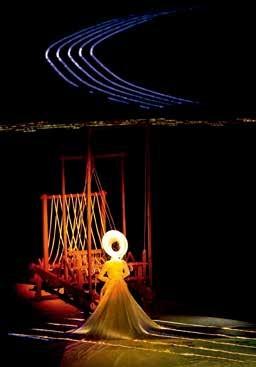广西-东盟:碧海丝路文化情
向雯

广西北海,园博园大剧院座无虚席,伴随着悠扬的背景音乐,汉代丝绸之路的起始路线缓缓呈现在大屏幕上。满载丝绸、茶叶与瓷器的大船,颇具特色的渔家婚礼,异域风情的服饰与歌舞……大气磅礴的布景和演员的精彩表演将观众带入了那段古老而又辉煌的历史中。
这场以2000多年前北海合浦大浪港汉代海上丝绸之路历史为背景的视听盛宴,展示了中国古代海上丝绸之路的灿烂文化。一段古老的海上丝绸之路,有道不完的动人故事,一部《碧海丝路》也向世人展示着北海“海上丝绸之路始发港”的深厚文化底蕴。
广西,地处祖国南部,多年来,坐拥沿海的区位优势,经济发展却一直滞后是人们对广西的固有印象。然而,伴随着中国-东盟的合作不断深化,广西抓住机遇华丽转身,以“东盟对口贸易省”身份重回人们视野。
作为我国唯一与东盟国家陆海相邻的省份,广西同时也是“丝绸之路经济带”与“海上丝绸之路”有机衔接的交汇点。沿海、沿江、沿边,这些得天独厚的区位优势让广西在与东盟的合作中,展现出其他省份无法比肩的地缘优势。如今,东盟已连续19年成为广西最大的贸易伙伴。
如果说历史长河中的古丝路,促成了中国与东盟国家之间商贸的互通有无,那么,如今中国与东盟的交流合作,内容已远非局限在经济范畴。在这片广袤的土地上,多彩的传统文化在这里交相辉映,频繁而亲密的人文交流奏响了中国与东盟友好交往的乐章。
搭乘T8701次国际列车,从广西南宁一路向南,经凭祥友谊关口岸出境,便可直达越南首都河内。除了沿途的美景,最吸引人的还有异域独特的风土人情。在越南,流连于千年古城之中,在当地美食、传统水上木偶戏中细细品味越南传统文化的精髓;在缅甸,从那些无处不在的佛塔、风格鲜明的传统民族舞蹈中去感受这个多民族国家的多彩文化;在柬埔寨,吴哥窟、柏威夏寺、三波坡雷古寺等世界文化遗产,至今闪耀着柬埔寨人民智慧的光芒……
今年6月6日,南宁艺术家带着中国传统戏剧、非遗展示等文化瑰宝走进了缅甸和老挝。在缅甸仰光国立文化艺术大学,艺术家们将舞剧《刘三姐》的精彩片段带给了观众,精湛的演出赢得观众阵阵喝彩;在老挝国立大学孔子学院,中国戏曲展演让台下的老挝学生陶醉其中,表演结束后,一些学生主动找演员“取经”,体验中国传统戏曲表演中水袖、长绸的魅力。同台表演的老挝青年艺术家金茉莉说:“跟南宁的艺术家一起表演,大家非常有默契,用动作甚至一个眼神就能交流。”
在为期8天的2019年“文化走亲东盟行”活动中,绚丽多姿的中国文化跟当地民众来了个“亲密接触”。实际上,从2014年起,“文化走亲东盟行”活动就开始举办,如今已成功举办5届,活动走进了新加坡、马来西亚、柬埔寨、越南、菲律宾、印度尼西亚、泰国等国,受到东盟国家民众的欢迎,成为广西深化与东盟文化旅游交往的品牌活动。
“今年是新中国成立70周年,‘文化走亲’以彰显文化旅游新理念、拓展‘以走促亲’的对外文化交流体系,进一步增进了中国与东盟之间的民心相通。”南宁市民族文化艺术研究院院长方宁谈到。
早在2003年,南宁就被国务院确定为中国-东盟博览会(以下简称“东博会”)永久会址,这朵白色“朱槿花”造型的会展中心盛开在了民歌湖边,成为了邕城一座标志性建筑。依托东博会的契机,广西搭建了中国-东盟文化论坛、东博会文化展、动漫游戏展等一系列形式多样、内容丰富的文化交流合作平台,向世界展示了中国和东盟人文交往的丰硕成果。与此同时,东盟各国的优秀演艺节目也走进广西,通过中国-东盟(南宁)戏剧周、中国-东盟(南宁)戏曲演唱会等平台展示,让中国观众领略了东盟各国的人文风情。
7月5日-8日,2019东博会文化展和动漫游戲展在广西南宁开展,此次展览以“共建21世纪海上丝绸之路,促进中国-东盟文化合作”为主旨,吸引了200多家中国及印尼、泰国、马来西亚、日本、韩国等“一带一路”沿线国家企业参展交流、洽谈签约。
“中国与东盟地缘相近,人文相通,文化产业合作前景广阔。”广西壮族自治区文化和旅游厅厅长甘霖表示,广西寻求与东盟各国深化文化领域合作,携手优化文化产业布局,欢迎中外特别是东盟各国的优秀文化通过这个平台向世界展示魅力。
展会上,阿富汗的手工地毯、泰国手工艺品、赞比亚木雕骨雕、巴基斯坦的青白玉和羊绒……琳琅满目的外国商品让参观者应接不暇;东盟风情表演、次元文化大赏、电竞嘉年华等丰富多彩的活动也给观众留下了深刻印象。来自泰国的展商Tassorn告诉记者:“这是我第一次来参展,这里观众很多,主办方很用心,下次我还会来参加。”
此外,动漫展的国外展商Avell Enterprise、Motion Capsule Studio、IFiQ Studio等也备受关注。在Avell Enterprise展位前,观众正在了解其动漫出版等产品;在文化展采购对接会上,来自巴基斯坦的JAVED SIDDIQ KNITWEAR(PRIVATE)LTD.对非物质文化遗产传统手工艺颇有好感,希望在此次展会上能寻求合作,促进中国企业和巴基斯坦企业的互利共赢。
9月下旬,第16届东博会即将举办,中国驻东盟大使黄溪连表示,“一带一路”倡议与《东盟互联互通总体规划2025》目标契合,期待第16届东博会更好地发挥本地区高层对话与商业合作的平台作用,推动 “一带一路”倡议下的务实合作,为推进中国-东盟战略伙伴关系作出积极贡献。
随着中国-东盟贸易往来日益密切、文化交流成果丰硕,双方也形成了交流往来的新格局。中国-东盟中心秘书长杨秀萍表示,人文交流已经成为中国-东盟关系的新亮点,中国与东盟文化经济互通的人才需求日益增大。
截至2018年底,广西高校已与周边国家近200所院校建立了合作关系,有32所学校招收外国留学生。最近5年,来广西留学的人数年均增长20%,累计超过5.7万人,其中东盟国家4.2万人。此外,中国已在东盟国家建立了多个文化中心。
正在广西大学攻读中国-东盟区域发展专业博士的方彩雯谈起了对广西的喜爱,“我很喜欢广西,气候好,食物也好吃,我最喜欢吃广西特色小吃螺蛳粉。”她计划毕业后留在广西从事教育领域的工作,为中泰文化交流贡献自己的一份力量。
而让泰国大学生南纳帕·戴蓬印象深刻的是,在中国参加短期学习交流期间,她发现在中国能看到很多泰国电视剧。“在泰国,很多人喜欢中国电视剧《包青天》,没想到在中国也有很多人喜欢泰剧。”
数据显示,2018年,中国文化产业增加值占GDP比重升至4.3% ,已经成为推动经济高质量发展、促进创新创业、满足人民美好生活追求的重要动力。近些年,广西与东盟各国在影视、动漫、游戏产业领域的交流合作也在不断发力,合作领域也由文化交流拓展到“文化+旅游+演艺”的全领域合作模式。
由广西与东盟国家合作拍摄的《海上新丝路》《江边的孩子》《光阴的故事》《再见,再也不见》等反映中国和东盟文化的影视剧、纪录片,播出后深受老百姓的喜爱。除了影视剧,山水实景演出在中国-东盟文化合作中也表现亮眼。
2010年,由中柬两国艺术家共同编创的大型文化旅游驻场演出《吴哥的微笑》,登陆柬埔寨后受捧至今;
2017年7月,中越首个合作实景演出项目《玄珍公主》在越南岘港首演;
2018年3月18日,一场由中越两国艺术家联袂打造的山水实景演出《越南往事》在越南会安首演,“行走”与“穿越”的视觉印象,让观众们叹为观止。
《越南往事》重现了昔日东南亚最大商埠的繁华与辉煌,让观众身临其境地感受到这座千年古城蕴含的生机和神韵……《越南往事》总导演梅帅元表示:“我们在山水间用中国方式讲世界故事,弘揚‘人类命运共同体’的思想理念。我们期待和平的薪火代代相传,让文化的光芒熠熠生辉。”
我们也期待,通过不断创新文化交流、产业合作的方式,古老的东方智慧一定会在山水相连的中国-东盟热土上焕发出更加夺目的光彩。
Located in Beihai, Guangxi Province, the Expo Garden Grand Theater enjoyed a full house. The starting route of the Silk Road in the Han Dynasty was slowly presented on the screen with melodious background music. Seeing the actors’ wonderful performances and all the magnificent scenery, such as large ships loaded with silk, tea and porcelain, fishermen’s weddings with distinctive features, exotic costumes and dances, the audience might thought that they were making a tour into the ancient and glorious history.
Such a feast for eyes and ears which was based on the history of the Han Dynasty Maritime Silk Road in Dalang Port, Hepu, Beihai more than 2,000 years ago, showed the splendid cultures of the ancient Chinese Maritime Silk Road. There were endless moving stories behind the ancient maritime Silk Road, and the Maritime Silk Road also showed the world the profound cultural foundation of “the set sail ports of the Maritime Silk Road” in the North Sea.

Located in the southern part of China, Guangxi has enjoyed the geographical advantages as a coastal province for many years. People used to be impressed by a stereotype of Guangxi as a place with poordeveloped economy. However, with the deepening cooperation between China and ASEAN, Guangxi has seized the opportunity to make a splendid turnaround and returned to people’s vision as an“ASEAN counterpart trade province”.
As the only province in China that is adjacent to the ASEAN countries both in land and sea region, Guangxi is also the intersection of the Silk Road Economic Belt and the Maritime Silk Road. Located along the coast, the river and the border, Guangxi is endowed with the geographical advantage that other provinces cannot match in the cooperation with ASEAN. Now, ASEAN has been Guangxi’s largest trading partner for 19 consecutive years.
If the ancient Silk Road in the long history has contributed to the exchange of trade between China and ASEAN countries, the exchanges and cooperation between China and ASEAN nowadays are far from being limited to the economic category. On this vast land, colorful traditional cultures contrast finely with each other, and frequent and intimate people-to-people exchanges have played a movement of friendly exchanges between China and ASEAN.
If you take the T8701 international train from Nanning, Guangxi, all the way south to Pingxiang Friendship Pass, you can reach Hanoi, the capital of Vietnam. Apart from the beautiful scenery along the way, the most attractive thing is the exotic local conditions and customs. In Vietnam, lingering in a thousand-year-old ancient city, you can savor the essence of traditional Vietnamese cultures from local cuisines and traditional water puppet shows; In Myanmar, you will be greeted by the colorful cultures of this multi-ethnic country when you see the ubiquitous stupas and traditional folk dances with distinctive styles; in Cambodia, the World Heritages of Angkor Wat, Temple of Preah Vihear and Sambor Prei Kuk still shine for the wisdom of the Cambodian people. On June 6 this year, the artists from Nanning entered Myanmar and Laos with cultural treasures such as traditional Chinese dramas and other intangible cultural heritages. At Rangoon National University of Culture and Arts in Myanmar, the artists presented wonderful clips of the dance drama“Liu Sanjie” to the audience, drawing loud applause from the audience. At the Confucius Institute at the National University of Laos, many Lao students were so charmed by the Chinese opera performance that they took the initiative to talk to the actors to learn the classics and the charm of the long sleeves in the traditional Chinese opera performances after the performance. Kim Jasmine, a young Lao artist who performed on the same stage, said, “With the artists from Nanning, we have a very tacit understanding. We can communicate with each other with gestures and even with one eye contact.”

During the eight-day “Cultural Walk to the ASEAN” campaign in 2019, the gorgeous Chinese cultures came into “close contact” with the local people. In fact, since 2014, the “Cultural Walk to the ASEAN”campaign has been successfully held for 5 sessions. The event has travelled through Singapore, Malaysia, Cambodia, Vietnam, the Philippines, Indonesia, Thailand and other countries, and has been welcomed by the people of ASEAN countries. It has become a brand activity for Guangxi to deepen the cultural and tourism exchanges with ASEAN countries.
Fang Ning, Director of Nanning National Culture and Art Research Institute, said, “It is the 70th anniversary of the founding of New China this year. The ‘Cultural Walk’ is made to highlight the new concept of cultural tourism and expand the foreign cultural exchange system of ‘better exchange through cultural walk’, in order to further enhance the communication between China and ASEAN.”
Early in 2003, Nanning was chosen by the State Council as the permanent site for ChinaASEAN Exposition (CAEXPO). Since then, the white “hibiscus-shaped” conference and exhibition center has been “blossoming” along the Minge Lake, existing as a landmark in Nanning. Taking advantage of the CAEXPO, Guangxi has built a host of diverse platforms for cultural exchange, such as China-ASEAN Cultural Forum, ChinaASEAN Culture Exhibition, and Animation and Game Show, showcasing the rich fruits of ChinaASEAN cultural exchanges. Meanwhile, outstanding artistic performance programs of ASEAN countries are also being brought to Guangxi. With the launch of China-ASEAN Theatre Week, China-ASEAN Opera Concert of Nanning, and other events, Chinese audiences have appreciated the cultural charm of ASEAN countries.
During July 5-8, China-ASEAN Expo Culture Exhibition and Animation and Game Show 2019 was launched in Nanning, Guangxi. With the theme “Cobuilding the 21st Century Maritime Silk Road and Promoting China-ASEAN Cultural Cooperation”, the event attracted 200-plus enterprises from China, Indonesia, Thailand, Malaysia, Japan, Korea, and other countries along the Belt and Road for visiting, exchange, negotiation, and contract signing.
“Since China and ASEAN are linked both geographically and culturally, we share a bright future in cultural industry cooperation.” Guangxi is seeking closer cultural cooperation with ASEAN countries to refine the layout of cultural industry; fine cultures, especially those of ASEAN countries are welcome to grace the stage of the platform, said Gan Lin, Director General of the Department of Culture and Tourism of Guangxi Zhuang Autonomous Region.
At the expo, visitors were impressed by the wide range of foreign goods, such as Afghan handmade carpets, Thai handicrafts, Zambia woodcarving and bone carving, and Pakistani light greenish white jade and cashmere wool, as well as ASEAN performance, sub-culture show, electronic sports carnival, and other colorful activities. “It is my first visit to the expo. The audiences are large in number and the organizer is very considerate. I will come for the next session,”Thai exhibitor Tassorn told the reporter.
Besides, at the Animation and Game Show, Avell Enterprise, Motion Capsule Studio, and IFiQ Studio also gathered spotlights. In front of Avell Enterprise’s booth, visitors were learning about its animation publishing and other products; at the purchasing matchmaking conference of the Cultural Expo, Pakistani company JAVED SIDDIQ KNITWEAR(PRIVATE)LTD. showed great interest in traditional handicrafts of intangible cultural heritage, and hoped for cooperation at the expo to promote mutual benefits between Chinese and Pakistani enterprises.
In late September, the 16th CAEXPO will be held. “The Belt and Road Initiative echoes with the Master Plan on ASEAN Connectivity 2025 in terms of objective, and the 16th CAEXPO is expected to better leverage on its role as a platform facilitating regional high-level dialog and business cooperation, boost practical cooperation under the Initiative and contribute to closer China-ASEAN Strategic Partnership,” said Huang Xilian, Chinese Ambassador to ASEAN.
The closer China-ASEAN trade and greater results of cultural exchanges have enabled a new layout of bilateral people-to-people exchanges. Cultural exchange has emerged as a new highlight in China-ASEAN relations, which calls for more talents in China-ASEAN cultural and economic exchanges, said Yang Xiuping, Secretary General of ASEANChina Centre.
As of the end of 2018, colleges and universities in Guangxi have establishment partnership with nearly 200 counterparts in neighboring countries, and 32 of them are recruiting foreign students. Over the past five years, the number of foreign students choosing to study in Guangxi has maintained an annual increase rate of 20%, totaling over 57 thousand, including 42 thousand from ASEAN countries. Meanwhile, China has established a number of cultural centers in ASEAN countries.
Fang Caiwen, who is pursuing the doctor’s degree in China-ASEAN regional development in Guangxi University, talked about how she loves Guangxi, “I love Guangxi very much for the nice climate and delicious food, especially Luosifen(snail rice noodle), a local snack.” She plans to engage in education field in Guangxi after graduation, so as to do her due part for China-Thailand cultural exchange.

What impressed Thai college student Namapa Depong deeply was that, during her short stay in China, she found that many Thai TV series are played in China.“In Thailand, many people love to watch Chinese TV drama Justice Bao. It is surprising that there are so many Chinese who love Thai TV drama.”
Data shows that in 2018, the share of the value added of Chinese cultural industry in GDP increased to 4.3%. That shows that cultural industry had become a key driver boosting high-quality economic development, promoting innovation and entrepreneurship, and meeting people’s demands for a better life. In recent years, Guangxi has made greater efforts in communication and cooperation with ASEAN countries in film and television, animation, and game industry, and cooperation fields have expanded beyond cultural exchange to feature an all-round model of “culture + tourism + artistic performance”.
Guangxi and ASEAN countries have worked together to produce a number of TV dramas and documentaries mirroring Chinese and ASEAN culture, such as The New Maritime Silk Road, Children along the River, Time Story, and Distance, all well-received among the audience. What’s more, landscape reality show is also a highlight in China- ASEAN cultural cooperation.
In 2010, Smile of Angkor, a large-scale cultural and tourism on-site performance, co-produced by Chinese and Cambodian artists, hit the stage of Cambodia as a great success.
In July 2017, Princess Xuan Zhen, the first liveaction performance program co-created by Chinese and Vietnamese artists, premiered in Da Nang, Vietnam.
On March 18, 2018, a landscape reality show Once Upon a Time in Vietnam, co-produced by Chinese and Vietnamese artists, premiered in Hoi An, Vietnam. The visual impression of “walking” and“time-traveling” awed the audience.
Once Upon a Time in Vietnam relives the past prosperity and splendor of the largest trading port in Southeast Asia and made audience feel the vitality and charm of the millennium-old city. Mei Shuaiyuan, General Director of Once Upon a Time in Vietnam, said, “We are telling stories of the world in a Chinese style amid landscape, aiming to pass on the concept of ‘a community of shared future for mankind’. We expect the torch of peace to be passed down from one generation to another for more brilliant cultures.”
We also hope to identify new ways of cultural exchange and industrial cooperation, in a way to bring more splendors to the land of China and ASEAN with ancient oriental wisdom.

